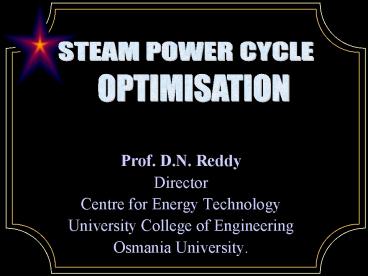Prof. D.N. Reddy PowerPoint PPT Presentation
1 / 30
Title: Prof. D.N. Reddy
1
STEAM POWER CYCLE
OPTIMISATION
- Prof. D.N. Reddy
- Director
- Centre for Energy Technology
- University College of Engineering
- Osmania University.
2
- Thermal performance
- The main impact of the Supercritical Cycle is to
increase the overall plant efficiency by reducing
Fuel consumption for Unit of Power Generated.
3
- Reduction in CO2 emissions to the extent of 15
- ? sub-critical 38 ? supercritical 45
at 600 oC - Temp 650 700oC ? 50 55
4
- Steam Cycle performance
- 1969 - 36
- 1985 - 40
- 1990 - 43-44
- 2000 Double Re-heat - 45-46
5
- Improvement in Efficiency
- Increase in Main Steam Pressure and Re-heat Steam
Temp - Final Feed Water Temperature
- ( Depends on Increase in No.of Re-heat stages
and Number of Feed Water Heaters)
6
- BOILER EXIT GAS TEMPERATURE
- ( 20oC reduction increases Efficiency by 1.1)
- Condensor pressure
- Reduction of Auxillary Power Consumption
- Improvement in Component Efficiencies
7
- Part Load Efficiency
- Part load Reduction on Efficiency
- Sub-critical 75 - 4
- 50 - 10-11
- Super-critical 75 - 2
- 50 - 5.5 8
8
- Boiler Design Optimisation
- Sub-Critical Boilers - Drum Boilers Steam
and Water Separated in the evaporator - Super-Critical - Once-through design
9
- Two pass and Tower Design
- Combustion Zone - Spirally Wound Membrane /
inclined tubing preferable - Increase in Pressure - Thicker sections /
Higher and Temp grade composition
10
- Current state of Art
- Boiler out let Steam Pressure and Temperature
300 bar/580-600 oC - Limitations
- Boiler Furnace Wall
- Complex Welding
11
- Vertical Furnace Tube Design
- Cheaper and less Complex Furnace Design
- Easier Furnace Framing
- Lower Pressure Drop (higher efficiency)
12
- Current status of Turbine Design
- Shaft Speeds - 3000-3600 rpm
- Inlet Steam conditions - 240 bar/565oC
- 300 bar/600oC
- Output 1100 MW
13
- Feed Water Pumps
- Boiler Feed Water Pumps - 3-4 of gross
- power output
- Feed Water Temperature - 280 300oC
- Flue Gas Temperature - 120oC
- (can be reduced to 80oC using Heat Recovery
System) - Upstream Flue gas De-Sulfurization
14
- Improvement in Efficiency
- Heat Recovery System 0.6 Coal Fired
- 1.0 Lignite Fire
15
- Turbine and Cycle Optimisation
- Improved blading profiles making use of Modern
CFD Technologies - Higher Final Feed Temperature and Bled Steam
Temperature - Bled Steam Tapping off the HP cylinder
16
- Improved Efficiency of Auxillaries
- Lower condenser pressures using larger condensers
and large exhaust areas - Large unit sizes improving Turbine Efficiencies
- Increasing automation and level of controls
- Optimising plant layout
17
- Alternate Boiler Technologies
- Gasification Cycles
- FBCs AFBC
- PFBC
- CFBC
- HRSG to Power a Turbogenerator
18
Schematic Diagram of a Steam Power Plant
19
Process Plant Diagram
20
Steam Turbine Cycle
21
The Ideal Reheat Cycle
22
The Ideal Regenerative Cycle
23
Regenerative Cycle with Open Feed Water Heater
24
Closed Feed Water Heater
25
(No Transcript)
26
Effect of Boiler Pressure on Rankine-Cycle
Efficiency
27
(No Transcript)
28
Pressure of Turbine Inlet
29
(No Transcript)
30
THANK 'U'

